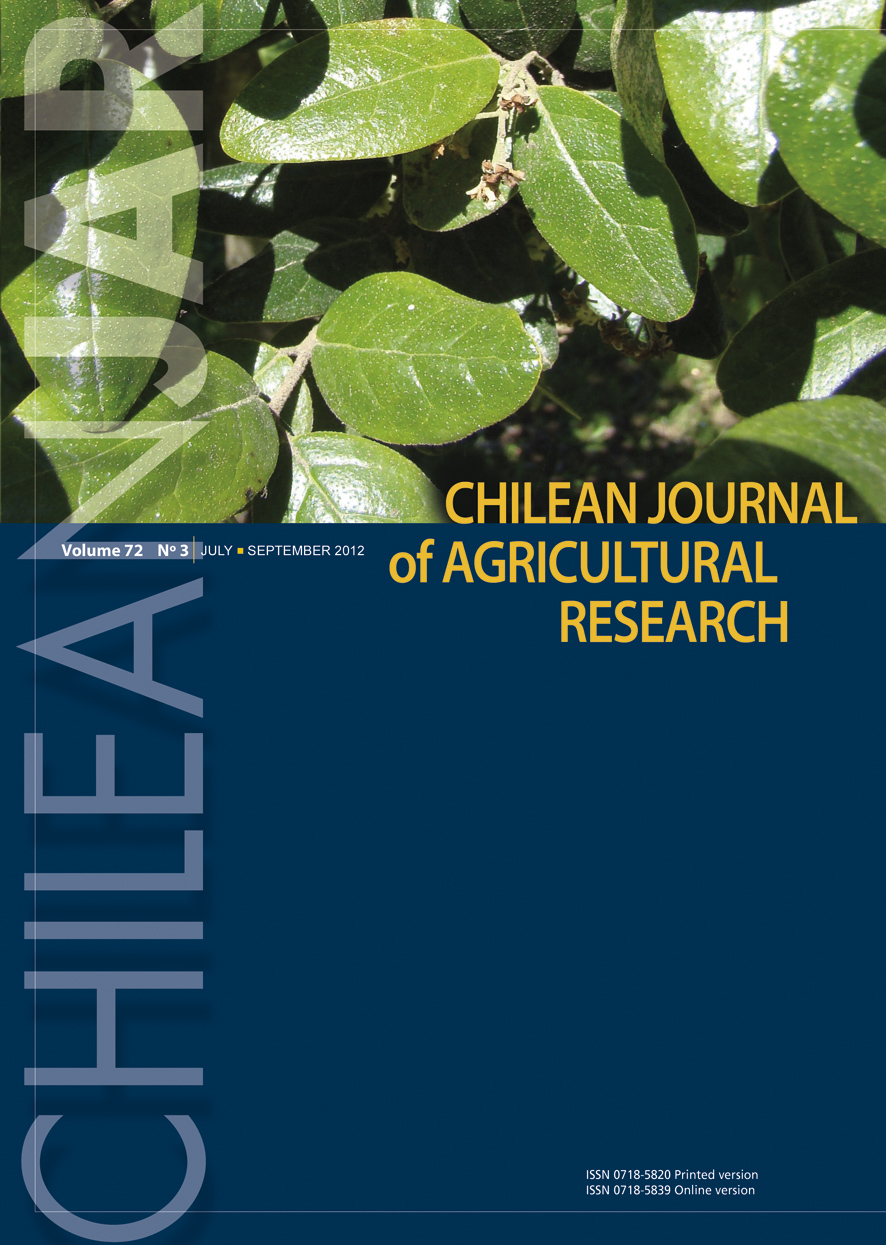
|
Chilean Journal of Agricultural Research
Instituto de Investigaciones Agropecuarias, INIA
ISSN: 0718-5820
EISSN: 0718-5820
Vol. 69, No. 1, 2009, pp. 12-20
|
 Bioline Code: cj09002
Bioline Code: cj09002
Full paper language: Spanish
Document type: Research Article
Document available free of charge
|
|
|
Chilean Journal of Agricultural Research, Vol. 69, No. 1, 2009, pp. 12-20
| en |
Effect of the Irrigation Canal Network on Surface and Groundwater Interactions in the Lower Valley of the Cachapoal River, Chile
Arumí, José Luis; Rivera, Diego; Holzapfel, Eduardo; Boochs, Peter; Billib, Max & Fernald, Alexander
Abstract
Agricultural production of high value crops in Chile's Central Valley is highly dependent on surface and groundwater resources. They are connected and together form an integrated hydrological system, the individual components of which have to be studied. This research is addressed to answering two questions: 1) to what extent doirrigation and canal seepage contribute to groundwater recharge and 2) what is the influence of the interactions between the Cachapoal River and ground water. The study was carried out from 2003 to 2007 in Peumo Valley (34.3° S, 71.3° W). In winter, the irrigation canal network intercepts and diverts surface runoff, which flows to flat areas and recharges groundwater. In summer, infiltration from the canals recharges the aquifer directly and partially compensates for water uptake from plants and evaporation. The effects of both interactions keep groundwater at a relatively constant level over the whole year. The water balance of the valley is strongly affected by agricultural practices, groundwater recharge mainly originating from irrigation loss (22%) and canal seepage (52%). It is important to know how management decisions, such as change in irrigation practices or canal lining, can affect the hydrological system and agricultural production within the valley.
Keywords
agriculture, Chile, groundwater, irrigation seepage, MODFLOW, surface water-groundwater interactions.
|
| |
| es |
Efecto de la Red de Canales de Riego en las Interacciones de Agua Superficial y Subterránea en la Parte Baja del Valle del Río Cachapoal, Chile.
Arumí, José Luis; Rivera, Diego; Holzapfel, Eduardo; Boochs, Peter; Billib, Max & Fernald, Alexander
Resumen
La producción agrícola de exportación en la Zona Central de Chile es altamente dependiente de los recursos hídricos superficiales y subterráneos, los que a su vez están conectados formando un solo sistema hidrológico a través de procesos que no están bien estudiados. Esta investigación apunta a responder dos preguntas de trabajo: 1) Entender el efecto de las filtraciones de los canales de riego en la recarga de los sistemas de aguas subterráneas; y 2) Identificar los patrones de interacción entre las aguas subterráneas y superficiales en el valle de Peumo. Este estudio se ejecutó entre los años 2003 y 2007 en el valle de Peumo, localizado en la Tercera Sección del Río Cachapoal, Región del Libertador General Bernardo O´Higgins, Chile (34,3° S, 71,3° O). En invierno, la red de canales que no transporta agua actúa como una red de drenes interceptores que desvía la escorrentía invernal, que en otro caso llegaría a las zonas planas y recargaría el acuífero. En verano, la infiltración desde los canales recarga el acuífero compensando las demandas de agua por evapotranspiración. El efecto de esta interacción es la estabilidad de los niveles freáticos durante todo el año. La hidrología del valle es afectada por las prácticas agrícolas; la recarga de agua subterránea proviene principalmente de pérdidas de riego (22%) e infiltración desde los canales (52%), por esa razón es importante entender de qué forma las decisiones de manejo, como el revestimiento de canales, pueden modificar el balance de aguas en el valle y su potencial productivo.
Palabras-clave
aguas subterráneas, filtraciones por riego, MODFLOW, interacciones aguas superficiales-subterráneas.
|
| |
© Copyright 2009 - Universidade de Santa Cruz do Sul
Alternative site location: http://www.inia.cl
|
|
